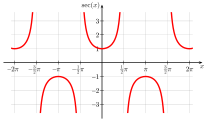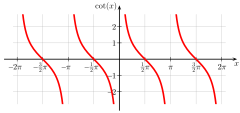Secant, Cosecant, and Cotangent[edit | edit source]
The secant of an angle is the reciprocal of its cosine.

The cosecant of an angle is the reciprocal of its sine.
 [note 1]
[note 1]
The cotangent of an angle is the reciprocal of its tangent.

-
Graph of sec x
-
Graph of cosec x
-
Graph of cot x
Solving Equations with Secants, Cosecants, and Cotangents[edit | edit source]
Solving an equation with secants, cosecants, or cotangents is pretty much the same method as with any other trigonometric equation.
e.g. Solve  for
for 

 and
and  , therefore
, therefore 
Pythagorean-derived identities[edit | edit source]
The Pythagorean trigonometric identity states that  . We can divide both sides by
. We can divide both sides by  to obtain another identity:
to obtain another identity:  . Alternatively, we can divide both sides by
. Alternatively, we can divide both sides by  to obtain
to obtain  .
.
The addition formulae are used when we have a trigonometric function applied to a sum or difference, e.g.  .
.
For sine, cosine, and tangent, the addition formulae are:[note 2]

The double angle formulae are a special case of the addition formulae, when both of the terms in the sum are equal.

Converting  to
to  or
or  [edit | edit source]
[edit | edit source]
It is helpful when solving trigonometric equations to convert an expression into a single term. To do this, we can use the addition formulae.
e.g. Solve  for
for 

Using  is pretty similar.
is pretty similar.
e.g. Solve  for
for 

- Notes
- ↑ Some sources may use
 , but this notation is not endorsed by Cambridge
, but this notation is not endorsed by Cambridge
- ↑ The proofs of these formulae are beyond the scope of the Cambridge Syllabus, but you can read about the proofs at Wikipedia
← Logarithmic and Exponential Functions · Differentiation →




























